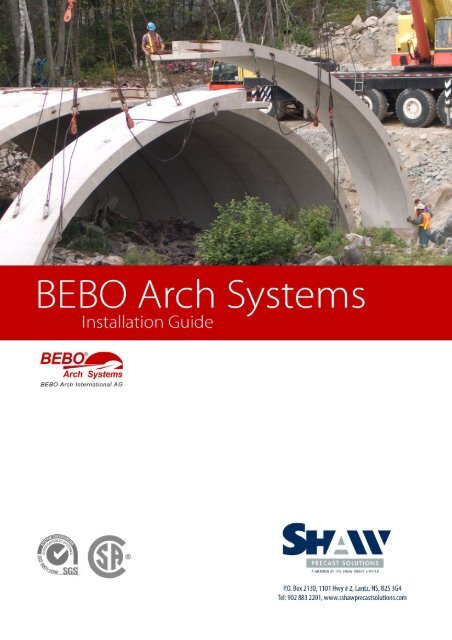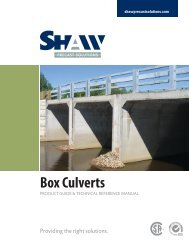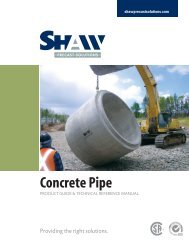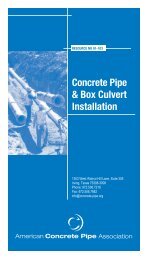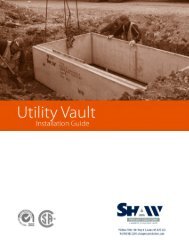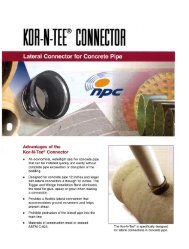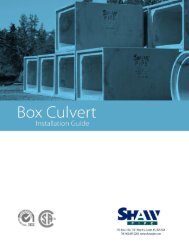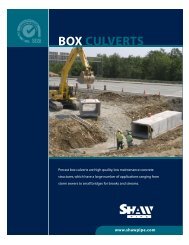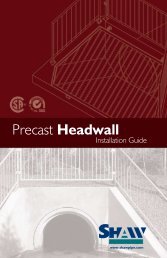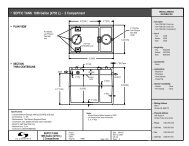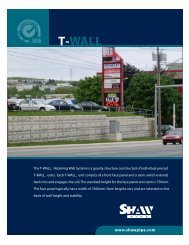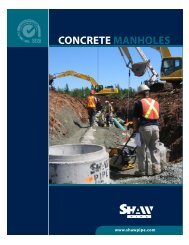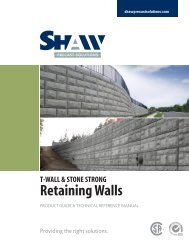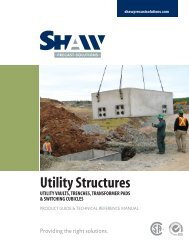BEBO System Instructions - Shaw Precast Solutions
BEBO System Instructions - Shaw Precast Solutions
BEBO System Instructions - Shaw Precast Solutions
Create successful ePaper yourself
Turn your PDF publications into a flip-book with our unique Google optimized e-Paper software.
<strong>BEBO</strong> ®<br />
Arch <strong>System</strong>s<br />
Copyright © 2009 by <strong>BEBO</strong> Arch International AG<br />
Foreword<br />
i<br />
<strong>BEBO</strong> <strong>System</strong> Technical Documentation<br />
Foreword<br />
This instruction booklet outlines the construction procedures and specifications required to<br />
install <strong>BEBO</strong> <strong>System</strong> arch structures. It also covers the installation of precast spandrel walls<br />
and wing walls where used. It should be read in connection with the project design drawings<br />
and the <strong>BEBO</strong> <strong>System</strong> Technical Guide.<br />
This document is relevant for all <strong>BEBO</strong> Series arches.<br />
Prior to the commencement of a project, all supervisory personnel should carefully review<br />
these construction and installation instructions. A <strong>BEBO</strong> representative can be made<br />
available on request to be present at the construction site during installation. The<br />
responsibilities of this representative are to provide advice on the installation of the <strong>BEBO</strong><br />
<strong>System</strong> and to act as an observer. If he observes any incorrect or unsafe practices, these will<br />
immediately be drawn to the attention of the site supervisor for his action. The <strong>BEBO</strong><br />
representative, however, cannot assume liability for the construction procedure.<br />
The information and data presented in this document is applicable for standard <strong>BEBO</strong> Arch<br />
<strong>System</strong> installations. The potential to use the <strong>BEBO</strong> Arch <strong>System</strong> must be evaluated on a<br />
project basis by a Consulting Engineer. Project specific data should also be provided to allow<br />
the engineer to determine the suitability, possible construction problems and other factors<br />
affecting the installation.<br />
Statements in this guide are not to be construed as guarantees nor implied warranties.<br />
In addition to the present instructions the <strong>BEBO</strong> <strong>System</strong> Risk List must be considered.<br />
The instructions provided in this document are specific only for <strong>BEBO</strong> <strong>System</strong><br />
applications. For non-<strong>BEBO</strong> specific details, tasks or situations, appropriate<br />
construction standards and procedures are to be followed.<br />
Document Revisions<br />
Issued Verified Approved<br />
Modifications Visum/Date Visum/Date Visum/Date<br />
2006 Release Ni – Sep 06 W – Sep 06 W – Sep 06<br />
Backfill Zone Revised Ni – Jan 07 W – Jan 07 W – Jan 07<br />
3 rd Edition, 2009 SB – Aug 09 W - Sep 09 Ni - Sep 09
<strong>BEBO</strong> ®<br />
Arch <strong>System</strong>s<br />
iii<br />
<strong>BEBO</strong> <strong>System</strong> Technical Documentation<br />
TOC<br />
A. FABRICATION, HANDLING AND TRANSPORTATION ...............................................1<br />
1. Fabrication.....................................................................................................................1<br />
1.1 Applicable Design Standards .............................................................................................. 1<br />
1.2 Concrete .............................................................................................................................. 1<br />
1.3 Reinforcing Steel ................................................................................................................. 1<br />
1.4 Minimum Concrete Cover over Reinforcement ................................................................... 1<br />
1.5 Accuracy/Tolerances for Elements...................................................................................... 1<br />
2. Handling and Transportation .........................................................................................2<br />
2.1 Cure Time............................................................................................................................ 2<br />
2.2 Arch Elements ..................................................................................................................... 2<br />
2.3 Spandrel Wall Segments..................................................................................................... 4<br />
2.4 Wing Wall Elements ............................................................................................................ 5<br />
2.5 MSE Walls and Other <strong>System</strong>s ........................................................................................... 6<br />
B. CONSTRUCTION..........................................................................................................7<br />
1. Foundations...................................................................................................................7<br />
1.1 Foundation Design .............................................................................................................. 7<br />
1.2 Critical Dimensions for Foundations.................................................................................... 7<br />
1.2.1 Critical Dimensions- Single Leaf.........................................................................................................................8<br />
1.2.2 Critical Dimensions- Twin Leaf ...........................................................................................................................9<br />
2. Levelling Pads .............................................................................................................10<br />
2.1 Arch Element Levelling Pads ............................................................................................ 10<br />
2.2 Spandrel Wall / Wing Wall Levelling Pads ........................................................................ 11<br />
3. Scour Protection ..........................................................................................................11<br />
4. Drainage ......................................................................................................................12<br />
C. INSTALLATION PROCEDURES FOR PRECAST ELEMENTS..................................13<br />
1. General Requirements ................................................................................................13<br />
1.1 Cranes ............................................................................................................................... 13<br />
1.2 Rigging............................................................................................................................... 13<br />
1.3 Tools .................................................................................................................................. 13<br />
1.4 Arch Positioning Aids......................................................................................................... 14<br />
2. Site Preparation...........................................................................................................14<br />
2.1 Final Checks...................................................................................................................... 14<br />
2.2 Setting Out......................................................................................................................... 14<br />
3. Installation of Arch Elements .......................................................................................17<br />
3.1 Single Leaf Arches ............................................................................................................ 18<br />
3.2 Twin Leaf Arches............................................................................................................... 22<br />
4. Installation of Other Elements .....................................................................................29<br />
4.1 Installation of Wing Walls .................................................................................................. 29<br />
4.2 Installation of Spandrel Walls ............................................................................................ 29<br />
4.3 Installation of MSE Spandrel Walls and Wing Walls ......................................................... 29<br />
4.4 Installation of Bevelled Ends ............................................................................................. 29<br />
5. Grouting.......................................................................................................................31<br />
6. Waterproofing ..............................................................................................................33<br />
D. SPECIFICATIONS FOR BACKFILLING......................................................................35<br />
1. Critical Backfilling Zones .............................................................................................35<br />
2. Required Backfill Properties ........................................................................................36<br />
2.1 Zone A ............................................................................................................................... 36<br />
2.2 Zone B ............................................................................................................................... 36<br />
2.3 Zone C ............................................................................................................................... 38<br />
3. Placing and Compacting Fill ........................................................................................38<br />
3.1 General Requirements and Procedures............................................................................ 38<br />
3.2 Weight Restrictions for Construction Machinery ............................................................... 41<br />
E. INSPECTIONS ............................................................................................................43<br />
1. Settlements and Horizontal Displacements.................................................................43<br />
F. T-SERIES........................................................................................................................45<br />
APPENDIX A.............................................................................................................................I<br />
APPENDIX B.............................................................................................................................I<br />
APPENDIX C.............................................................................................................................I
<strong>BEBO</strong> ®<br />
Arch <strong>System</strong>s<br />
1. FABRICATION<br />
1.1 Applicable Design Standards<br />
1<br />
<strong>BEBO</strong> <strong>System</strong> Technical Documentation<br />
Part A - Fabrication, Handling and Transportation<br />
A. Fabrication, Handling and Transportation<br />
Fabrication of <strong>BEBO</strong> <strong>System</strong> elements must conform to the design drawings and the<br />
provisions of one of the following design codes (as specified on the drawings and in<br />
the structural design documentation of a specific project):<br />
• AASHTO, Standard Specifications for Highway Bridges, 16 th Edition, 1996;<br />
• AASHTO, LRFD Bridge Design Specifications, 3rd Edition, 2003;<br />
• British Standard, BS5400;<br />
• Canadian CSI S6-00, Canadian Highway Bridge Design Code;<br />
• Eurocode EC0 to EC7<br />
On a project specific basis, other design codes (e.g. DIN, etc.) can be accounted for.<br />
Please contact <strong>BEBO</strong> Arch International AG for more information.<br />
1.2 Concrete<br />
As indicated in drawings.<br />
1.3 Reinforcing Steel<br />
As indicated in drawings.<br />
No cold worked reinforcing steel of low ductility shall be used.<br />
1.4 Minimum Concrete Cover over Reinforcement<br />
As indicated in drawings.<br />
1.5 Accuracy/Tolerances for Elements<br />
All <strong>BEBO</strong> <strong>System</strong> elements must be accurate to within ± 6 mm of their specified<br />
dimensions. Special care must be administered when casting bearing surfaces to<br />
ensure they will join correctly with other system elements.
<strong>BEBO</strong> ®<br />
Arch <strong>System</strong>s<br />
2. HANDLING AND TRANSPORTATION<br />
2.1 Cure Time<br />
2<br />
<strong>BEBO</strong> <strong>System</strong> Technical Documentation<br />
Part A - Fabrication, Handling and Transportation<br />
<strong>BEBO</strong> <strong>System</strong> elements must not be lifted from their casting beds until their<br />
strength is sufficient to prevent damage. The strength of the concrete must be great<br />
enough, so that, when lifted, the cast-in-place anchor pins are not pulled out from the<br />
concrete. The manufacturer of the anchor pins should be contacted to find the<br />
minimum concrete strength required, to be able to lift through the anchor pins and<br />
thus to lift the element.<br />
2.2 Arch Elements<br />
Care must be exercised in handling and moving <strong>BEBO</strong> <strong>System</strong> arch elements. <strong>BEBO</strong><br />
arch elements are designed to be cast, lifted, stored and hauled in an upright<br />
position as shown in Figure 1.<br />
Careless or rough handling can not only be dangerous, but can also stress the<br />
element to a higher degree than would occur in the final structure. This mishandling<br />
can lead to the production of unnecessary cracking.<br />
Figure 1: Casting, Lifting, Storage and Hauling Position of<br />
<strong>BEBO</strong> <strong>System</strong> Arch Elements<br />
Arch elements are only to be lifted through the use of the anchors cast into the arch.<br />
The required locations of the anchors are specified in the drawings. Arch elements<br />
must not be lifted until the concrete has attained the specified strength.<br />
Figure 2: Lifting of <strong>BEBO</strong> <strong>System</strong> Arch Element
<strong>BEBO</strong> ®<br />
Arch <strong>System</strong>s<br />
3<br />
<strong>BEBO</strong> <strong>System</strong> Technical Documentation<br />
Part A - Fabrication, Handling and Transportation<br />
Arch elements must be properly stored to prevent cracking, deformations, or other<br />
damage. It is recommended that timber supports are used, such as those shown in<br />
Figure 3. It is advised that timber supports encased in plastic are used for end<br />
elements. Timber supports in direct contact with concrete can tarnish the concrete<br />
and thus the curb face of the element. Unnecessary markings should be avoided on<br />
visible surfaces of the structure.<br />
Figure 3: Storage of <strong>BEBO</strong> <strong>System</strong> Arch Element<br />
Arch elements must not be shipped until the concrete has attained the specified<br />
compressive design strength (28 days).<br />
Arch elements are shipped in the upright (as cast) position.<br />
Figure 4: Transportation of Arch Element<br />
NOTE: Ensure that the arch elements are correctly fixed during transportation.<br />
They should be sufficiently secured to be able to deal with sloping truck decks<br />
in the event of uneven road surfaces (site access roads).
<strong>BEBO</strong> ®<br />
Arch <strong>System</strong>s<br />
2.3 Spandrel Wall Segments<br />
4<br />
<strong>BEBO</strong> <strong>System</strong> Technical Documentation<br />
Part A - Fabrication, Handling and Transportation<br />
Spandrel wall segments are cast, stored and shipped in the flat position.<br />
Figure 5: <strong>BEBO</strong> <strong>System</strong> Spandrel Wall Segments’ Casting,<br />
Storage and Transportation Position<br />
Spandrel Wall segments should only be lifted through the use of the cast-in anchors<br />
provided. The locations of the anchors are specified in the drawings.<br />
Figure 6: Lifting <strong>BEBO</strong> <strong>System</strong> Spandrel Wall Segments<br />
Store spandrel wall segments using timber supports as appropriate. Supports should<br />
be provided at the same locations as the cast-in-anchors in order to avoid<br />
loading/support conditions that differ from those assumed in the structural design.
<strong>BEBO</strong> ®<br />
Arch <strong>System</strong>s<br />
5<br />
<strong>BEBO</strong> <strong>System</strong> Technical Documentation<br />
Part A - Fabrication, Handling and Transportation<br />
Ensure that the side of the spandrel wall that will be visible in the final structure is<br />
facing upwards and is not in contact with the wooden supports. The wooden supports<br />
can leave unsightly marks on the element and it is desirable that these marks cannot<br />
be seen on the completed structure.<br />
Figure 7: Storage of Spandrel Wall Segments<br />
Spandrel wall segments must not be shipped until the concrete has attained the<br />
specified compressive design strength (28 days).<br />
2.4 Wing Wall Elements<br />
Wing wall elements are cast, stored and shipped as shown in Figure 8.<br />
Figure 8: Casting, Storage and Shipping Position of Wing Wall Elements<br />
Wing wall elements should only be lifted through the use of the cast-in anchors<br />
provided. The locations of the anchors are specified in the drawings.
<strong>BEBO</strong> ®<br />
Arch <strong>System</strong>s<br />
6<br />
<strong>BEBO</strong> <strong>System</strong> Technical Documentation<br />
Part A - Fabrication, Handling and Transportation<br />
Figure 9: Lifting of a <strong>BEBO</strong> <strong>System</strong> Wing Wall Element<br />
Store wing wall elements using timber supports as appropriate.<br />
Figure 10: Storage of Wing Wall Element<br />
Wing wall elements must not be shipped until their concrete has attained the<br />
specified compressive design strength (28 days).<br />
2.5 MSE Walls and Other <strong>System</strong>s<br />
When non-<strong>BEBO</strong> spandrel and wingwalls are used that are compatible with the<br />
<strong>BEBO</strong> system, the product supplier must be contacted. The handling and<br />
transportation methods recommended by the product supplier must be used.
<strong>BEBO</strong> ®<br />
Arch <strong>System</strong>s<br />
B. Construction<br />
1. FOUNDATIONS<br />
1.1 Foundation Design<br />
7<br />
<strong>BEBO</strong> <strong>System</strong> Technical Documentation<br />
Part B - Construction<br />
Various types of foundations can be used for <strong>BEBO</strong> <strong>System</strong> structures. The type of<br />
foundation used depends on the circumstances encountered at each specific site.<br />
Most often, cast-in-place spread footings are used and are normally strip footings with<br />
a pedestal.<br />
A generic footing design can be found in the <strong>BEBO</strong> <strong>System</strong> Technical Guide.<br />
The foundations for arch elements, spandrel and wing walls must be connected by<br />
reinforcement to form one full length monolithic body. Expansion joints are not<br />
necessary (except under special conditions). Shrinkage and temperature cracks are<br />
acceptable and do not detract from the system’s performance, durability and safety.<br />
1.2 Critical Dimensions for Foundations<br />
To ensure the correct installation of <strong>BEBO</strong> <strong>System</strong> elements, care and caution must<br />
be exercised in forming the support areas for the arch, spandrel and wing wall<br />
elements. Exercising special care will facilitate the rapid installation of the precast<br />
components.<br />
It is important that the support area is constructed to the correct dimensions. These<br />
dimensions vary between arch type, size and subtype. It is important that the<br />
constructed dimensions correspond to the arch type being used.<br />
The required dimensions are calculated differently for twin and single leaf arches.<br />
Please see the following sections for how to calculate the foundation dimensions for<br />
the required arch type.<br />
The dimensions of the foundations/support areas should be rechecked BEFORE<br />
installation commences, along with the following criteria:<br />
• The arch keyway is correctly aligned along the length of the foundation.<br />
• The total length of the keyway should correspond to the sum of the widths of all<br />
arch elements, plus a 10 mm gap between each arch.<br />
• The width of the keyway is correct for the arch type being used. See Appendix C<br />
for the keyway widths for each arch.
<strong>BEBO</strong> ®<br />
Arch <strong>System</strong>s<br />
1.2.1 Critical Dimensions- Single Leaf<br />
8<br />
<strong>BEBO</strong> <strong>System</strong> Technical Documentation<br />
Part B - Construction<br />
The distance X (as shown in Figure 11) is the distance between the backs of the two<br />
keyways. This distance allows for the span of the arch, plus sufficient space for the<br />
hardwood wedges and grouting.<br />
X is defined as:<br />
Where:<br />
X = So + 200mm<br />
• So = is the span of the arch measured to the outside of the arch<br />
• X = distance from back of keyway to back of keyway<br />
Figure 11: Critical Dimensions for Foundation Construction<br />
See Appendix A for the dimension So and X for each arch size.
<strong>BEBO</strong> ®<br />
Arch <strong>System</strong>s<br />
1.2.2 Critical Dimensions - Twin Leaf<br />
9<br />
<strong>BEBO</strong> <strong>System</strong> Technical Documentation<br />
Part B - Construction<br />
Twin leaf arch structures experience deformation under self-weight upon installation.<br />
For a proper installation of the arches this deformation must be compensated and the<br />
setting out span of the arches must be such that the actual crown level corresponds<br />
to the theoretical one.<br />
X is defined as follows. Note that S0 is replaced by Sdeformed:<br />
X = Sdeformed + 200mm<br />
See Appendix A for the dimension So and X for each arch size. Note that these are<br />
approximate values, because the deformations of reinforced concrete, naturally,<br />
experience considerable scatter.
<strong>BEBO</strong> ®<br />
Arch <strong>System</strong>s<br />
2. LEVELLING PADS<br />
2.1 Arch Element Levelling Pads<br />
10<br />
<strong>BEBO</strong> <strong>System</strong> Technical Documentation<br />
Part B - Construction<br />
Levelling pads are required to guarantee the correct seating of the arch elements.<br />
Levelling pads can be either grout poured into the arch keyway or masonite shims.<br />
Material selection is at the contractor’s discretion. Levelling pads must be<br />
approximately 50 mm thick, the width of the entire keyway and 600 mm long. This is<br />
to ensure that each arch element is resting on approximately 300 mm of pad at each<br />
joint (see Figure 13).<br />
Figure 13: Arch Element Levelling Pads<br />
The levelling pads are to be poured to within 3 mm of the required elevation.<br />
The proportion, by loose volume, of cement to sand for the mortar mix must be<br />
1 to 2.<br />
No loads are allowed on the mortar levelling pads within 72 hours of their<br />
placement. Alternatively, fast setting cement can be used.
<strong>BEBO</strong> ®<br />
Arch <strong>System</strong>s<br />
2.2 Spandrel Wall / Wing Wall Levelling Pads<br />
11<br />
<strong>BEBO</strong> <strong>System</strong> Technical Documentation<br />
Part B - Construction<br />
Levelling pads are also required to guarantee the correct seating of the spandrel and<br />
wing walls. Incorrect seating leads to unsightly level differences of the bridge<br />
components.<br />
Levelling pads must be approximately 50 mm thick and are to be poured to within 3<br />
mm of the required elevation.<br />
Levelling pads for wing walls must be constructed in a layout that allows each<br />
element to be supported at each corner as shown in Figure 14.<br />
Figure 14: Wing Wall Levelling Pads<br />
The proportion, by loose volume, of cement to sand for the mortar mix must be<br />
1 to 2.<br />
No loads are allowed on the mortar levelling pads within 72 hours of their placement.<br />
Alternatively, fast setting cement can be used.<br />
3. SCOUR PROTECTION<br />
Install scour protection to footings and bed of stream if required, according to the<br />
recommendations of the project’s consulting engineer.<br />
NOTE: Statistically, scour is the most frequent cause of bridge collapse<br />
worldwide.
<strong>BEBO</strong> ®<br />
Arch <strong>System</strong>s<br />
4. DRAINAGE<br />
12<br />
<strong>BEBO</strong> <strong>System</strong> Technical Documentation<br />
Part B - Construction<br />
The design of the standard system elements makes no specific allowance for<br />
hydrostatic pressure due to high ground water levels. When such conditions are<br />
present the structure should be adequately drained or the water pressure taken into<br />
account in the calculations.<br />
Suggested drainage lines are shown in Figure 15.<br />
In order to avoid the washing out of fines (piping) all drainage lines (including weep<br />
holes) must be enclosed in or covered by appropriate filters (geotextile and/or<br />
filter packages) as shown in Figure 16.<br />
Note: Severe damage to the structure can occur if fines are washed out. Take<br />
special care where the structure is under frequent or constant water spill.<br />
Water mains behind the structure if broken can cause critical damage.<br />
Figure 15: Drainage Line Locations<br />
Figure 16: Drainage Lines- Cross-section
<strong>BEBO</strong> ®<br />
Arch <strong>System</strong>s<br />
1. GENERAL REQUIREMENTS<br />
1.1 Cranes<br />
13<br />
<strong>BEBO</strong> <strong>System</strong> Technical Documentation<br />
Part C - Installation Procedures for <strong>Precast</strong> Elements<br />
C. Installation Procedures for <strong>Precast</strong><br />
Elements<br />
The recommended method for installing the precast elements utilises one or two<br />
double-drum cranes with equal capacity on each drum.<br />
If you are considering using an alternative method (to that which utilises a doubledrum<br />
crane), please contact <strong>BEBO</strong> Arch International AG engineers to develop<br />
appropriate alternative installation procedures.<br />
It is the responsibility of the contractor to ensure that cranes of correct lifting capacity<br />
are available to handle the precast elements. This can be accomplished by using the<br />
weights given for <strong>BEBO</strong> <strong>System</strong> components and by determining the lifting reach for<br />
each crane element. It is also the responsibility of the contractor to ensure that the<br />
cranes are correctly positioned on the ground. Site conditions must be checked well<br />
in advance of shipping to ensure proper crane location and to avoid any lifting<br />
restrictions.<br />
It has been found through experience that trying to use a minimal crane size actually<br />
leads to inefficiencies and not to the desired efficiencies. As a general rule: a<br />
somewhat bigger crane gives a more efficient solution.<br />
1.2 Rigging<br />
Appropriate sized rigging cables and snatch blocks based on <strong>BEBO</strong> requirements<br />
should be available onsite. Cables of wrong lengths cause the arch to hang<br />
incorrectly and can cause not only problems on site, but can damage the element.<br />
The snatch blocks should be well lubricated to avoid corrosion or problems with<br />
sticking which can cause the arch not to hang plumb. Ropes should be on hand to<br />
control the arch during installation.<br />
1.3 Tools<br />
The following tools can be useful on site:<br />
• Pinch point crow bars (2 per side)<br />
• Sledge hammers (1 per side)<br />
• Maul (to drive crown joints into place)<br />
• Deep socket ratchets to tighten crown joint bolt (banana bolt)<br />
• Chalk, tape measure and level (for setting out and checking)
<strong>BEBO</strong> ®<br />
Arch <strong>System</strong>s<br />
1.4 Arch Positioning Aids<br />
14<br />
<strong>BEBO</strong> <strong>System</strong> Technical Documentation<br />
Part C - Installation Procedures for <strong>Precast</strong> Elements<br />
The following aids are recommended to assist with the positioning of the arch:<br />
• A sufficient quantity of 40 x 190 x 400 mm concrete blocks should be available to<br />
allow their placement at two locations per arch leaf. These blocks are placed<br />
between the keyways back wall and the outside arch leg and are used to prevent<br />
lateral spreading of the arch after installation.<br />
• Hardwood wedges to drive between the arch leg and the concrete blocks to adjust<br />
the position of the arch.<br />
• 10 mm thick wooden boards, to be used to create the correct spacing between<br />
the elements as they are being positioned.<br />
• 5 mm and 10 mm thick steel plate shims for various shimming purposes.<br />
2. SITE PREPARATION<br />
To ensure a smooth installation, a well prepared site is recommended.<br />
2.1 Final Checks<br />
The dimension of the keyway should be checked to ensure:<br />
• That the keyways are parallel<br />
• That the keyways are of the correct length. The length should be sufficient to<br />
accommodate all arch segments, plus a 10 mm spacing between each arch<br />
segment.<br />
• The width of the keyway is correct for the arch type being used.<br />
• The distance between the keyways is correct (As discussed in Section B 1.2 Page<br />
7).<br />
2.2 Setting Out<br />
To ensure the correct positioning of the arch elements, it is recommended that lines<br />
of reference are drawn onto the keyways. These lines can then serve as a constant<br />
check of the orientation of the arches as the installation progresses.<br />
One approach to setting out is to draw chalk lines onto the floors of the keyways.<br />
These lines are drawn at the desired final location of the outside-face of the arch.<br />
NOTE: These lines also run over the levelling pads and are shown in Figure 17.
<strong>BEBO</strong> ®<br />
Arch <strong>System</strong>s<br />
Figure 17: Setting-out Method 1 (Plan view)<br />
15<br />
<strong>BEBO</strong> <strong>System</strong> Technical Documentation<br />
Part C - Installation Procedures for <strong>Precast</strong> Elements<br />
While this method has been used extensively, it has been found by some contractors<br />
that under certain conditions it can be difficult to see the chalk line, when the arch<br />
segments are being lowered into place.<br />
To overcome this problem, an alternative approach has been developed which<br />
continues to use a chalk line, but changes its location to improve visibility.<br />
Figure 18: Setting-out Method 2 (Plan view)
<strong>BEBO</strong> ®<br />
Arch <strong>System</strong>s<br />
16<br />
<strong>BEBO</strong> <strong>System</strong> Technical Documentation<br />
Part C - Installation Procedures for <strong>Precast</strong> Elements<br />
In this method the chalk line is drawn on the outer curb of the footing (Figure 18),<br />
instead of inside the keyway, Figure 18. A ruler is then used to measure the required<br />
distance between the line and the outside of the arch leg. This method is shown in<br />
Figure 19.<br />
Figure 19: Setting-out Method 2
<strong>BEBO</strong> ®<br />
Arch <strong>System</strong>s<br />
3. INSTALLATION OF ARCH ELEMENTS<br />
17<br />
<strong>BEBO</strong> <strong>System</strong> Technical Documentation<br />
Part C - Installation Procedures for <strong>Precast</strong> Elements<br />
Arch elements should be stored on the ground on site, only if appropriate protection<br />
measures are taken (see Page 3). Ideally they should be delivered to site, lifted from<br />
the truck and set directly on the foundations.<br />
Figure 20: Unsafe Storage Position of Arch<br />
Under no circumstances should the arch be stored as shown in Figure 20. If it is felt<br />
necessary to adopt such a position, contact <strong>BEBO</strong> Arch engineers for advice before<br />
such a position is adopted.<br />
Spandrel wall segments and wing wall elements may be unloaded and placed on the<br />
ground on site until installed (see Pages 5 and 6 for storage details).<br />
The lift anchors provided in each element are the only means to be used to lift the<br />
precast elements. The elements must not be supported, stored or raised by other<br />
means than those given in the manuals and drawings.<br />
Make sure that an “Arch End Element” (an arch element with curb) is placed as the<br />
first and last element (if used).
<strong>BEBO</strong> ®<br />
Arch <strong>System</strong>s<br />
3.1 Single Leaf Arches<br />
18<br />
<strong>BEBO</strong> <strong>System</strong> Technical Documentation<br />
Part C - Installation Procedures for <strong>Precast</strong> Elements<br />
Single leaf arch elements are transported in the upright (as-cast) position as<br />
described in Section A 2.0 (Page 2). A crane is used to lift, rotate and place singleleaf<br />
arch elements in one exercise.<br />
Figure 21: Handling and Rotation of the Arch<br />
The arch element is then lowered into/onto the foundation key. It is imperative that<br />
any lateral spreading of the arch element be avoided during and after<br />
installation.<br />
This is achieved by the use of the arch positioning equipment given in Section B 1.4<br />
Page 15.<br />
Figure 22: Measuring the Gap between Arches (left) and Hardwood Blocks and Wedges in<br />
Keyway<br />
Hardwood<br />
wedge<br />
Hardwood<br />
block<br />
The concrete or hardwood blocks (shown in Figure 22) are placed between the<br />
keyway and the arch at a spacing of two blocks per arch leaf. These blocks can be<br />
rectangular or triangular in shape and can be made from either hardwood or<br />
concrete.<br />
Hardwood wedges are then driven in between the arch leg and the<br />
concrete/hardwood blocks (Figure 22). Wedges are always triangular shaped.
<strong>BEBO</strong> ®<br />
Arch <strong>System</strong>s<br />
19<br />
<strong>BEBO</strong> <strong>System</strong> Technical Documentation<br />
Part C - Installation Procedures for <strong>Precast</strong> Elements<br />
Figure 23: Wooden Spacing Board Sits between Arches (View from above)<br />
10 mm thick wooden boards are placed between the arch segments to create the<br />
correct spacing as shown in Figure 23.<br />
For grouting procedure please see Section 5.0 on Page 32<br />
NOTE: It is essential that these measures are in place before the release of the<br />
arch element from the crane.<br />
Figure 24 shows a single leaf T-Series arch being installed (Next two pages).
<strong>BEBO</strong> ®<br />
Arch <strong>System</strong>s<br />
20<br />
<strong>BEBO</strong> <strong>System</strong> Technical Documentation<br />
Part C - Installation Procedures for <strong>Precast</strong> Elements<br />
Figure 24: Installation of Single Leaf Arches with a Double Drum Crane
<strong>BEBO</strong> ®<br />
Arch <strong>System</strong>s<br />
21<br />
<strong>BEBO</strong> <strong>System</strong> Technical Documentation<br />
Part C - Installation Procedures for <strong>Precast</strong> Elements<br />
Figure 24 (cont.): Installation of Single Leaf Arches with a Double Drum Crane
<strong>BEBO</strong> ®<br />
Arch <strong>System</strong>s<br />
3.2 Twin Leaf Arches<br />
22<br />
<strong>BEBO</strong> <strong>System</strong> Technical Documentation<br />
Part C - Installation Procedures for <strong>Precast</strong> Elements<br />
Two double-drum cranes (or one double-drum crane and displaceable scaffolding)<br />
are required for the installation of the twin leaf precast arch elements.<br />
Ideally, one crane shall be located on each (outer) side of the foundations to<br />
independently lift half-arch elements from the delivery trucks and into position. The<br />
two twin elements are lifted and positioned simultaneously.<br />
Alternatively, if cranes are to be positioned on the same side of the foundations or<br />
within the arch span, they should be located so that the final jointing movement of the<br />
elements at the crown can be completed, without damaging the interlocking joint<br />
keys.<br />
• Ensure elements are shipped in pairs, male to one side of the crossing and<br />
female to the other (based on the crown joint).<br />
Twin-leaf arch elements are transported and lifted/rotated in a similar manner to<br />
single-leaf elements.<br />
• To minimise crane movement, start installing arch elements at maximum crane<br />
reach and work towards the crane location.<br />
• Ensure the arch elements are plumb once rotated.<br />
Once the first end elements are installed, reverse the delivery of the remaining<br />
elements in order that the arch leaf edge anchors are facing out from the installed<br />
structure. When oriented this way, the edge lifting devices can be removed once the<br />
elements are in place. Otherwise the lifting devices must be removed before the arch<br />
leaves are lowered into position (Figure 25).<br />
Inner face lifting<br />
anchors (end<br />
units only)<br />
Figure 25: Arch being Lifted into Place with the Lifting Devices on the Outside of the Element<br />
Figure 26 shows the installation procedure for twin leaf arches (Next two pages).
<strong>BEBO</strong> ®<br />
Arch <strong>System</strong>s<br />
23<br />
<strong>BEBO</strong> <strong>System</strong> Technical Documentation<br />
Part C - Installation Procedures for <strong>Precast</strong> Elements<br />
Figure 26: Double-drum Cranes Lifting, Turning and Installing a Pair of Twin Leaves
<strong>BEBO</strong> ®<br />
Arch <strong>System</strong>s<br />
24<br />
<strong>BEBO</strong> <strong>System</strong> Technical Documentation<br />
Part C - Installation Procedures for <strong>Precast</strong> Elements<br />
Figure 26(cont.): Double-drum Cranes Lifting, Turning and Installing a Pair of Twin Leaves
<strong>BEBO</strong> ®<br />
Arch <strong>System</strong>s<br />
25<br />
<strong>BEBO</strong> <strong>System</strong> Technical Documentation<br />
Part C - Installation Procedures for <strong>Precast</strong> Elements<br />
• Install the first arch leaf in its location with the crown 30 cm higher than the final<br />
resting location.<br />
• Install the second arch leaf to the same elevation.<br />
• Lower elements into place in unison.<br />
• To prevent damage to the elements, the following steps must be followed closely.<br />
These steps must be carried out before releasing the tension from the cables.<br />
The following checks must be made:<br />
1. The crown joint opening is correct (Vertical Section)<br />
Figure 27: Correct Position of the Arches at the Crown Joint<br />
2. The squareness of the arch elements is correct (left)<br />
Figure 28: Correct and Incorrect Squareness of the Arch Elements
<strong>BEBO</strong> ®<br />
Arch <strong>System</strong>s<br />
Hardwood<br />
wedges<br />
26<br />
<strong>BEBO</strong> <strong>System</strong> Technical Documentation<br />
Part C - Installation Procedures for <strong>Precast</strong> Elements<br />
When the squareness is not correct (as shown in the diagram on the right in Figure<br />
28) the following options are available to alleviate the problem:<br />
a. Place steel shims between arch and keyway towards the edge where the joint is<br />
open.<br />
b. Remove shims between arch and keyway towards the edge where the joint is<br />
tight.<br />
c. Place steel shims under arch leg at location where the crown joint is open (this is<br />
usually required when there appears to be a “twist” in the installation).<br />
Please note that the more time spent being accurate with the first elements leads to<br />
time savings while installing the remaining elements.<br />
3. Before releasing the load of each arch half element from the crane, both<br />
elements must be blocked at the foundation key in the correct position (the<br />
same procedure as for single leaves, see Section B 3.1 Page 19).<br />
Hardwood<br />
blocks<br />
Figure 29: Hardwood Blocks and Wedges Between the Arch and the Keyway<br />
4. Before the load is released, the curved tie rod (“banana bolt”) must also be<br />
inserted and fixed in the block-outs at the crown joint.<br />
Figure 30: Tie Rods (banana bolts) being inserted in the Crown Joint
<strong>BEBO</strong> ®<br />
Arch <strong>System</strong>s<br />
Figure 31: Tie Rods (banana bolts)<br />
27<br />
<strong>BEBO</strong> <strong>System</strong> Technical Documentation<br />
Part C - Installation Procedures for <strong>Precast</strong> Elements<br />
After all the above procedures have been completed (1.,2.,3.,4.), the tension in the<br />
cables can finally be fully released.<br />
The joints of the crown pockets must be waterproofed in preparation for the cast-inplace<br />
concrete. Reinforcement steel must then be inserted into the crown joint, before<br />
it is filled with cast-in-place concrete. This procedure should be carried out as shown<br />
in the drawings and in Figures 32,33,34.<br />
<strong>BEBO</strong> <strong>System</strong> twin leaf profiles are designed for the arch’s dead load to act on<br />
the three-pinned arch. In the case where scaffoldings are used for the<br />
installation, they must be removed (or lowered) before the crown joint is cast.<br />
Figure 32: Steel Reinforcement within Crown Joint (Pockets)
<strong>BEBO</strong> ®<br />
Arch <strong>System</strong>s<br />
Figure 33: Filling the Crown-Joint with Concrete<br />
Figure 34: Finished Crown Joint<br />
28<br />
<strong>BEBO</strong> <strong>System</strong> Technical Documentation<br />
Part C - Installation Procedures for <strong>Precast</strong> Elements<br />
The required compressive strengths for the cast-in-place crown joint concrete are<br />
listed in Appendix B.
<strong>BEBO</strong> ®<br />
Arch <strong>System</strong>s<br />
4. INSTALLATION OF OTHER ELEMENTS<br />
4.1 Installation of Wing Walls<br />
29<br />
<strong>BEBO</strong> <strong>System</strong> Technical Documentation<br />
Part C - Installation Procedures for <strong>Precast</strong> Elements<br />
A layer of mortar should be laid on to the foundation surface using the levelling pads<br />
for guidance. The wing wall elements can then be placed onto the levelling pads and<br />
wet mortar.<br />
Once the wingwalls are correctly positioned they must be connected to the<br />
foundation. Pre cast holes are provided in the wing walls for this purpose.<br />
A hole must be drilled into the foundation (through the precast holes in the wing wall<br />
footing). This hole must then be cleaned before it is filled with (typically) epoxy glue.<br />
A rod is then driven through the holes into the glue and then secured with a washer<br />
and a bolt.<br />
4.2 Installation of Spandrel Walls<br />
Place the spandrel wall segments onto the arch and foundations on a wet layer of<br />
mortar, starting with the centre piece. Add the adjoining lateral segments, attaching<br />
them temporarily to the arch end element and/or the wing walls.<br />
NOTE: Spandrel wall segments may be placed on twin leaf arches only after the<br />
keyway has been grouted, the arch crown joint has been cast and the concrete has<br />
attained its specified strength.<br />
The keyway joint between the spandrel wall and the first wing wall element should be<br />
clean, smooth and uniform so to provide an even bearing support for the spandrel<br />
wall.<br />
4.3 Installation of MSE Spandrel Walls and Wing Walls<br />
All MSE wall systems will be installed in accordance with the<br />
manufacturer’s/supplier’s specifications and requirements.<br />
4.4 Installation of Bevelled Ends<br />
The bevelled elements need to be attached to temporary works and propped or tied<br />
back to a firm stable binding. These props are normally required to stay in place for<br />
approximately two weeks after the elements have been stitched together.<br />
Once the bevelled elements have been craned into place, the hardwood blocks and<br />
other positioning equipment should be used to ensure their correct seating of the<br />
element. Once all elements are correctly positioned, the temporary supports can be<br />
swung into position.<br />
Final adjustments are then to be made to the temporary supports to level and align<br />
the elements. Once all temporary supports are in place, all elements should be<br />
checked for correct positioning and the required adjustments be made.
<strong>BEBO</strong> ®<br />
Arch <strong>System</strong>s<br />
30<br />
<strong>BEBO</strong> <strong>System</strong> Technical Documentation<br />
Part C - Installation Procedures for <strong>Precast</strong> Elements<br />
The bevelled ends solution is typically a more complicated solution, thus, when such<br />
a solution is chosen, detailed instructions and drawings are provided by <strong>BEBO</strong> Arch<br />
International AG.<br />
Figure 35: Bevelled Ends with Temporary Supports<br />
Figure 36: Temporary Supports for Bevelled Ends
<strong>BEBO</strong> ®<br />
Arch <strong>System</strong>s<br />
5. GROUTING<br />
31<br />
<strong>BEBO</strong> <strong>System</strong> Technical Documentation<br />
Part C - Installation Procedures for <strong>Precast</strong> Elements<br />
All grout shall be 35 N/mm 2 (or as specified in the drawings) with a maximum<br />
aggregate of 6 mm and a maximum water/cement ratio of 0.40 in order to reduce<br />
shrinkage effects. The grout must be sufficiently flowable so that it completely fills all<br />
voids.<br />
After the installation of all arch elements is complete, as per the instructions in Part C<br />
Section 3.0, the keyways must be grouted. The following procedure should be used:<br />
• Fill the arch keyway with grout. Make sure that the space directly beneath the<br />
blocked-up arch legs is completely filled. Under no circumstances should the<br />
hardwood wedges be removed within the first 72 hours after grouting.<br />
• After 72 hours the wedges should be removed and their holes filled in with grout.<br />
• Grout the wing wall footing anchor rod holes.<br />
• Fill the installation anchor recesses with grout.<br />
Figure 37: The Arch Footing before Grouting and the Arch Footing Filled with Grout, before<br />
the Removal of the Hardwood Wedges
<strong>BEBO</strong> ®<br />
Arch <strong>System</strong>s<br />
32<br />
<strong>BEBO</strong> <strong>System</strong> Technical Documentation<br />
Part C - Installation Procedures for <strong>Precast</strong> Elements<br />
Figure 38: Grouting complete: Hardwood Blocks have been Removed and the Holes They<br />
Left behind have been Filled with Grout
<strong>BEBO</strong> ®<br />
Arch <strong>System</strong>s<br />
6. WATERPROOFING<br />
33<br />
<strong>BEBO</strong> <strong>System</strong> Technical Documentation<br />
Part C - Installation Procedures for <strong>Precast</strong> Elements<br />
Various waterproofing measures can be used for a <strong>BEBO</strong> <strong>System</strong> structure. The<br />
waterproofing measures used are dependant on the specific requirements of each<br />
site.<br />
As a minimum, the joints between the arch elements must be sealed by placing<br />
sections of 40 mm diameter preformed mastic in each joint. The joint is then covered<br />
with a 300 mm wide strip of a waterproofing membrane. To ensure that the strips<br />
remain in place during backfilling, the strips must be cemented to the precast<br />
elements with an adhesive compound. Joints between spandrel and wing walls are<br />
also to be covered with a waterproofing membrane.<br />
A small strip of filter fabric is also cemented over the weep holes in the spandrel and<br />
wing wall elements (see drainage and required filters in Section B 5.0 Page 13).<br />
Figure 39: Waterproofing of a <strong>BEBO</strong> Structure<br />
Figure 39 shows the waterproofing of a <strong>BEBO</strong> structure in the USA.
<strong>BEBO</strong> ®<br />
Arch <strong>System</strong>s<br />
D. Specifications for Backfilling<br />
35<br />
<strong>BEBO</strong> <strong>System</strong> Technical Documentation<br />
Part D - Specifications for Backfilling<br />
The backfilling operation creates one of the most important series of loads experienced by<br />
the structure.<br />
The backfill is an integral, load carrying part of the structure. It must permanently fulfil its<br />
purpose.<br />
Severe damage to the structure can result if proper procedures are not followed.<br />
1. CRITICAL BACKFILLING ZONES<br />
The critical zones for backfilling are as indicated in the figures below:<br />
Figure 40: Citical Zones for Backfilling Alternative 1<br />
Figure 41: Critical Zones for Backfilling Alternative 2<br />
Zone A: Existing soil, well compacted embankment or overfill<br />
Zone B: Fill which is directly associated with bridge installation<br />
Zone C: Road structure
<strong>BEBO</strong> ®<br />
Arch <strong>System</strong>s<br />
2. REQUIRED BACKFILL PROPERTIES<br />
2.1 Zone A<br />
36<br />
<strong>BEBO</strong> <strong>System</strong> Technical Documentation<br />
Part D - Specifications for Backfilling<br />
Zone A requires natural ground or fill material with properties, filling procedures and<br />
compacting procedures, equal to that of normal road embankments.<br />
Natural ground is to be stable enough to effectively support the arch elements. As a<br />
guide, the existing natural ground should exhibit properties (especially density) which<br />
are similar to those of Zone B material. This should be true of the material which lies<br />
within a minimum lateral dimension of one arch span outside of the arch footing.<br />
2.2 Zone B<br />
Generally, soils that meet the following basic requirements are acceptable:<br />
φ' ≥ 30 0 (angle of internal friction, in compacted state)<br />
wL ≤ 40% (liquid limit)<br />
Ip ≤ 10% (plasticity index)<br />
Soils shall be reasonably free of organic matter, and, close to concrete surfaces, free<br />
of stones larger than 75 mm in diameter.<br />
Materials with gradations that fall within the following limits (shaded area of<br />
Figure 42), normally fulfil the above basic requirements:<br />
% Passing<br />
100<br />
90<br />
80<br />
70<br />
60<br />
50<br />
40<br />
30<br />
20<br />
10<br />
0<br />
Clay Silt Sand Gravel<br />
0.002 0.006 0.020 0.074 0.2 0.6 2 6 19 76 Opening [mm]<br />
Figure 42: Zone B Gradation Limits<br />
GW, GP, GM, GC,<br />
GM-ML, GM-GC,<br />
SW, SP, SM, SC,<br />
SM-ML, SM-SC<br />
(φ' 30 0 , wL 40%,<br />
Ip 10%: generally<br />
fulfilled )<br />
Soils should have a water content that allows the required compaction to be<br />
obtained. This is especially critical for soils of the USCS groups SM-ML and SM-SC.<br />
In order to avoid collapse settlement, soils should have a water content at the<br />
Proctor Optimum or slightly on the wet side. Avoid compacting soils on the dry side<br />
of the Proctor Optimum moisture content, since this can lead to collapse settlement<br />
when the water content increases.
<strong>BEBO</strong> ®<br />
TYPICAL<br />
USCS<br />
MATERIALS<br />
Arch <strong>System</strong>s<br />
37<br />
<strong>BEBO</strong> <strong>System</strong> Technical Documentation<br />
Part D - Specifications for Backfilling<br />
The following USCS soil groups are not acceptable as backfill material in their<br />
natural state:<br />
GC-CH (gravel with high plasticity clay)<br />
SC-CH (sand with high plasticity clay)<br />
CL (gravelly and/or sandy, clayey silt)<br />
OL (gravelly and/or sandy, organic silt)<br />
CH (gravelly and/or sandy, silty clay)<br />
OH (gravelly and/or sandy organic silty clay)<br />
MH (gravelly and/or sandy high plasticity silt)<br />
It is however possible to improve the strength of the majority of the soil types above<br />
by adding cement or lime and thus creating “soil cement". This material can then be<br />
used for backfilling.<br />
The soils OL AND OH however are exceptions in the above soil types. These soils<br />
should not be used as backfill material, even when mixed to create soil cement.<br />
The suitability of backfill material can also be determined using AASHTO Designation<br />
M 145-87. In general, soils groups A-1, A-2, A-3 and A-4 are acceptable (see Table 2<br />
below, Bureau of Public Roads Classification).<br />
Table 2: Acceptable and Non-acceptable Soils for AASHTO M 145-87<br />
Group<br />
Sub-<br />
Group<br />
10<br />
[2mm]<br />
Per Cent Passing<br />
U.S. Sieve No.<br />
40<br />
[0.4mm]<br />
200<br />
[0.074mm]<br />
Character of Fraction<br />
Passing No. 40 Sieve<br />
Liquid<br />
Limit<br />
Plasticity<br />
Index<br />
Group<br />
Index<br />
No.<br />
1)<br />
Soil Description<br />
GW, GP, SP A-1 50 max. 25 max. 6 max. 0 Well-graded gravel or sand; may include<br />
fines<br />
GM, SW, SP, SM A-1-a 50 max. 30 max. 15 max. 6 max. 0 Largely gravel but can include sand and<br />
fines<br />
A-1-b 50 max. 25 max. 6 max. 0 Gravelly sand or graded sand; may<br />
include fines<br />
GM, SM, ML, SP, GP A-2 35 max. 0 to 4 Sands and gravels with excessive fines<br />
SC, GC, GM A-2-4 35 max. 40 max. 10 max. 0 Sands, gravels with low-plasticity silt<br />
fines<br />
A-2-5 35 max. 41 min. 10 max. 0 Sands, gravels with plastic silt fines<br />
SC, GC A-2-6 35 max. 40 max. 11 min. 4 max. Sands, gravels with clay fines<br />
SC, GC A-2-7 35 max. 41 min. 11 min. 4 max. Sands, gravels with highly plastic clay<br />
fines<br />
SP,SM,SW A-3 51 min. 10 max. Nonplastic 0 Fine sands<br />
ML, SM, SC A-4 36 min. 40 max. 10 max. 0 max. Low-compressibility silts<br />
MH, OH, ML, OL A-5 36 min. 41 min. 10 max. 12 max. High-compressibility silts<br />
CL, ML, OL A-6 36 min. 40 max. 11 min. 16 max. Low-to-medium-compressibility clays<br />
A-7 36 min. 41 min. 11 min. 20 max. High-compressibility clays<br />
OL, CH, MH, OH, CL, ML A-7-5 36 min. 41 min. 11 min. 20 max. High-compressibility silty clays<br />
OH, CH, MH, CL, ML, OL A-7-6 36 min. 41 min. 11 min. 20 max. High compressibility, high-volumechange<br />
clays<br />
PT, OH A-8 Peat, highly organic soils<br />
Acceptable Soils Non-acceptable Soils<br />
1)<br />
Determination of Group Index No. see formulae below:<br />
Group Index GI = (F - 35) ⋅ [0.2 + 0.005 ⋅ (LL - 40)] + 0.01 ⋅ (F - 15) ⋅ (PI - 10), in which:<br />
F = Percentage passing No. 200 (0.074 mm) sieve, expressed as a whole<br />
number. This percentage is based only on the material passing the<br />
3-in (75 mm) sieve.<br />
LL = liquid limit<br />
PI = plasticity index<br />
Index No. 0 - 4 indicates a "good" material<br />
Index No. 5 - 14 indicates a "fair" material<br />
Index No. 15 - 19 indicates a "poor" material<br />
Index No. 20 or greater indicates a "very poor" material
<strong>BEBO</strong> ®<br />
Arch <strong>System</strong>s<br />
38<br />
<strong>BEBO</strong> <strong>System</strong> Technical Documentation<br />
Part D - Specifications for Backfilling<br />
The necessary fill properties for Zone B can also be achieved by the use of<br />
Controlled Low-Strength Materials (CLSM; flowable or self-compacting fill). This<br />
can be particularly beneficial in restricted conditions (narrow excavations) where<br />
compacting is difficult and/or when placement of backfill is time-consuming (multiplespan<br />
structures). Compressive strengths of 0.7 N/mm 2 or less are appropriate for<br />
CLSM. Contact <strong>BEBO</strong> in specific cases.<br />
2.3 Zone C<br />
Zone C is the road section and consists of gravel, asphalt or concrete built in<br />
compliance with local engineering practices. The standard minimum overfill height<br />
is 0.45 m over the crown of the arch (including the pavement). There should be<br />
at least 100 mm of select fill between the arch extrados and the bottom of the<br />
pavement. Shallower overfill heights are possible under certain conditions. Contact<br />
<strong>BEBO</strong> Arch International AG for more information.<br />
All standard designs use a specific weight of 20kN/m 3 for Zone B and C material.<br />
Differing specific weights (lightweight fill, iron ore, etc.) need to be analysed<br />
separately and checked by <strong>BEBO</strong> Arch International AG.<br />
3. PLACING AND COMPACTING FILL<br />
3.1 General Requirements and Procedures<br />
Backfilling operations at the sides of the arch shall not commence before the keyway<br />
grout has attained half of the required final compressive strength, i.e.17.5 N/mm 2 .<br />
For twin-leaf arches, the cast-in-place crown joint concrete must attain the full<br />
required compressive strength (see Appendix B), prior to starting the backfilling<br />
operation.<br />
The dumping of backfill is not permitted within 1m of the structure. See Figure 43 for<br />
the extent of this 1m boundary.<br />
Figure 43: Restrictions on Dumping of Fill Material<br />
The fill must be placed and compacted in layers not exceeding 0.5 m in their<br />
compacted state. The maximum difference in the surface levels of the fill on opposite<br />
sides of the arch must not exceed 1.0 m. Marks are painted and numbered on arch<br />
elements to indicate each backfill level. This serves as a guide for equipment<br />
operators and helps to ensure that the maximum difference is not exceeded. In<br />
special cases, ask <strong>BEBO</strong> whether higher differences can be used.
<strong>BEBO</strong> ®<br />
Arch <strong>System</strong>s<br />
Figure 44: Guidance for Backfill Steps<br />
39<br />
<strong>BEBO</strong> <strong>System</strong> Technical Documentation<br />
Part D - Specifications for Backfilling<br />
The fill behind the wing walls must be placed at the same time as that of the arch fill<br />
and be placed in horizontal layers not exceeding 0.5 m per layer.<br />
The backfill of Zone B must be compacted to a minimum of 98% of the maximum<br />
dry density determined by the Proctor Standard test.
<strong>BEBO</strong> ®<br />
Arch <strong>System</strong>s<br />
40<br />
<strong>BEBO</strong> <strong>System</strong> Technical Documentation<br />
Part D - Specifications for Backfilling<br />
To avoid damage, fill located directly adjacent to the arch and spandrel walls as<br />
indicated in Figures 45 and 46 should be compacted using hand-operated equipment.<br />
Figure 45: Red Zone- Use Hand Operated Compaction Equipment Only<br />
Hand operated compaction<br />
equipment area<br />
Figure 46: Red Zone - Use Hand Operated Compaction Equipment Only
<strong>BEBO</strong> ®<br />
Arch <strong>System</strong>s<br />
41<br />
<strong>BEBO</strong> <strong>System</strong> Technical Documentation<br />
Part D - Specifications for Backfilling<br />
Heavy vibrating compaction equipment should be started and switched off outside the<br />
limits for dumping as shown in Figure 43. The vibration frequency should be at least<br />
30 revolutions per second.<br />
Figure 47: Compaction with a “Jumping Jack”<br />
Figure 48: Hand-operated and Heavy Compaction Equipment<br />
The backfill behind the wingwalls (outside of Zone B) requires no special material or<br />
compaction methods. This backfill should still however satisfy the requirements for<br />
normal embankments.<br />
3.2 Weight Restrictions for Construction Machinery<br />
In the immediate vicinity of the arch, there are restrictions for the use of heavy<br />
construction machinery during the backfilling operation.<br />
The bare arch may not be crossed by any construction equipment.<br />
The shaded area in Figure 49 is restricted to construction equipment with a maximum<br />
weight of 10 tonnes.
<strong>BEBO</strong> ®<br />
Arch <strong>System</strong>s<br />
Figure 49: Weight Restriction Area<br />
42<br />
<strong>BEBO</strong> <strong>System</strong> Technical Documentation<br />
Part D - Specifications for Backfilling<br />
After the compacted fill level has reached a minimum of 0.3m over the crown of the<br />
arch, construction equipment with a maximum weight of 30 tonnes may cross the<br />
arch.<br />
After the compacted fill level has reached 0.5 m over the crown of the arch,<br />
construction equipment within the design load limits for the road may cross the arch.<br />
Especially heavy equipment may cross the arch at greater depths of overfill. For the<br />
minimum depths of overfill required for specific extra heavy equipment, please<br />
consult <strong>BEBO</strong> Arch International AG engineers.
<strong>BEBO</strong> ®<br />
Arch <strong>System</strong>s<br />
E. Inspections<br />
43<br />
<strong>BEBO</strong> <strong>System</strong> Technical Documentation<br />
Part E - Inspections<br />
1. SETTLEMENTS AND HORIZONTAL DISPLACEMENTS<br />
Settlement and horizontal displacement of the foundations should be monitored to<br />
ensure that they are within the allowable design limits. The allowable values are given<br />
in the table in Figure 50. These values should give an indication of the acceptable<br />
settlements and deformations along the length of the foundations. In certain cases<br />
the allowable displacements will be given in the design documents of the specific<br />
<strong>BEBO</strong> structure.<br />
In general, the first measurement should take place after the installation of the <strong>BEBO</strong><br />
<strong>System</strong> elements, a second after completion of the backfilling and a third before the<br />
opening of the bridge to traffic. Further measurements can be required according to<br />
local conditions.<br />
Δ h<br />
(total span change)<br />
Δ v<br />
(between opposite<br />
footings)<br />
Displacement 1/1000 of arch span 1/200 of arch span<br />
Figure 50: Allowable Displacements for Foundations<br />
The maximum difference in vertical displacements ’v’ should not exceed 15 mm per<br />
10 m along the length of one foundation.<br />
In conjunction with possible horizontal displacements of the foundations, check for<br />
visible cracks in the concrete of the arch intrados. Fine or hairline cracks of up to 0.2<br />
mm are to be expected in the crown area and are not harmful.<br />
NOTE: The above values are very general and are often very conservative. Where<br />
large settlements are expected, contact <strong>BEBO</strong> Arch International for project specific<br />
advice.<br />
NOTE: There may be other (local) factors present which may require smaller<br />
allowable settlements/displacements. Such factors include nearby structures, service<br />
lines in the backfill (especially water and gas mains) or especially narrow tolerances<br />
at the top surface.
<strong>BEBO</strong> ®<br />
Arch <strong>System</strong>s<br />
F. T-Series<br />
45<br />
<strong>BEBO</strong> <strong>System</strong> Technical Documentation<br />
Part F - T-Series<br />
The construction and installation of the T- Series is similar to that of the E and C<br />
Series. There are, however, some key differences which need to be addressed and<br />
are discussed below. The differences and appropriate actions are described and<br />
where useful, the page number of the corresponding information for the E and C<br />
Series is given in brackets.<br />
• The foundations should be constructed as required by the project drawings.<br />
• The T-Series arch sits in a keyway which is constructed on to the foundation<br />
block. The main difference of the T-Series keyway, is that it has only an outer<br />
curb, unlike that of the E and C Series which usually has an outer and an inner<br />
curb. The distance between the two outer curbs is known as X ( Pages 8 and 9)<br />
and is found for the T Series arches using the formula below:<br />
Where:<br />
X = So + 200mm<br />
• So = is the span of the arch measured to the outside of the arch (Given in project<br />
drawings)<br />
• X = distance from back of keyway to back of keyway<br />
This formula is applicable for both single and twin leaf T-Series arches.<br />
• When a single leaf arch element is being installed, the actual span of the arch<br />
should be checked BEFORE the tension is released from the crane cables. This<br />
should be checked to ensure that there is NO SPREADING of the arch.<br />
• It is particularly important to check the crown level of twin leaf T-Series’ arches.<br />
The height of the crown should be measured by a surveyor while the crane cables<br />
are still under tension.<br />
• Under no circumstances should the crown level be below that of the specified<br />
level given in the drawings. A crown level which is up to 100 mm higher than the<br />
design level is acceptable. If the measured crown level is not within the specified<br />
limits, it must be adjusted using the “arch positioning equipment” BEFORE the<br />
tension is released from the crane cables.<br />
• The backfill applied to the T-Series arches does not significantly contribute to the<br />
carrying capacity of the arch, as it does with the C and E Series arches. As a<br />
result, there is no requirement for Type B backfill. All backfill over the arches is of<br />
Type A (See Page 35 for diagrams and Page 36 for further information) and thus<br />
needs to satisfy the requirements for normal road embankments.
<strong>BEBO</strong> ®<br />
Arch <strong>System</strong>s<br />
Appendix A<br />
Arch Outside Spans: E12 - E48<br />
APPENDIX A - i<br />
<strong>BEBO</strong> <strong>System</strong> Technical Documentation<br />
APPENDIX A<br />
E12 s o [mm] X [mm] E30 s o [mm] X [mm]<br />
E12/0 3782 3982 E30/0 9308 9508<br />
E12/1 3994 4194 E30/1 9502 9702<br />
E12/2 4064 4264 E30/2 9614 9814<br />
E12/3 4064 4264 E30/3 9652 9852<br />
E30/4 9652 9852<br />
E30/5 9652 9852<br />
E16 s o [m] X [mm]<br />
E16/0 4734 4934<br />
E16/1 5046 5246 E36 s o [m] X [mm]<br />
E16/2 5224 5424 E36/0 11048 11248<br />
E16/3 5282 5482 E36/1 11270 11470<br />
E16/4 5282 5482 E36/2 11412 11612<br />
E36/3 11476 11676<br />
E36/4 11480 11680<br />
E20 s o [m] X [mm]<br />
E20/0 6036 6236<br />
E20/1 6298 6498 E42 s o [m] X [mm]<br />
E20/2 6450 6650 E42/0 12878 13078<br />
E20/3 6502 6702 E42/1 13098 13298<br />
E20/4 6502 6702 E42/2 13242 13442<br />
E42/3 13306 13506<br />
E24 s o [m] X [mm]<br />
E24/0 7314 7514 E48 s o [m] X [mm]<br />
E24/1 7544 7744 E48/0 14964 15164<br />
E24/2 7676 7876 E48/1 15112 15312<br />
E24/3 7722 7922<br />
E24/4 7722 7922<br />
E24/5 7722 7922
<strong>BEBO</strong> ®<br />
Arch <strong>System</strong>s<br />
Arch Outside Spans: E54T - E84T; E15.5mT<br />
APPENDIX A - ii<br />
<strong>BEBO</strong> <strong>System</strong> Technical Documentation<br />
APPENDIX A<br />
E54T so [mm] 0s [mm] S deformed [mm] X [mm] E78T s o [mm] 0s [mm] Sdeformed [mm] X [mm]<br />
E54T/0 16936 10 16926 17126 E78T/0 24502 25 24477 24677<br />
E54T/1 17034 15 17019 17219 E78T/1 24566 34 24532 24732<br />
E54T/2 17070 20 17050 17250 E78T/2 24588 43 24545 24745<br />
E54T/3 17070 25 17046 17246 E78T/3 24588 52 24536 24736<br />
E54T/4 17070 29 17041 17241 E78T/4 24588 61 24527 24727<br />
E54T/5 17070 34 17036 17236 E78T/5 24588 70 24518 24718<br />
E54T/6 17070 39 17031 17231 E78T/6 24588 79 24509 24709<br />
E60T s o [mm] 0s [mm] Sdeformed [mm] X [mm] E84T s o [mm] 0s [mm] Sdeformed [mm] X [mm]<br />
E60T/0 18968 16 18952 19152 E84T/0 26338 28 26310 26510<br />
E60T/1 18999 21 18978 19178 E84T/1 26438 36 26402 26602<br />
E60T/2 18999 26 18973 19173 E84T/2 26496 43 26453 26653<br />
E60T/3 18999 31 18968 19168 E84T/3 26518 51 26467 26667<br />
E60T/4 18999 36 18963 19163 E84T/4 26518 58 26460 26660<br />
E60T/5 18999 41 18958 19158 E84T/5 26518 66 26452 26652<br />
E84T/6 26518 73 26445 26645<br />
E84T/7 26518 81 26437 26637<br />
E66T s o [mm] 0s [mm] Sdeformed [mm] X [mm] E15.5mT s o [mm] 0s [mm] Sdeformed [mm] X [mm]<br />
E66T/0 20802 23 20779 20979 E15.5T/0 15970 8 15962 16162<br />
E66T/1 20828 30 20798 20998 E15.5T/1 16066 12 16054 16254<br />
E66T/2 20828 37 20791 20991 E15.5T/2 16100 16 16084 16284<br />
E66T/3 20828 43 20785 20985 E15.5T/3 16100 19 16081 16281<br />
E66T/4 20828 50 20778 20978 E15.5T/4 16100 23 16077 16277<br />
E66T/5 20828 57 20771 20971 E15.5T/5 16100 27 16073 16273<br />
E15.5T/6 16100 31 16069 16269<br />
E72T s o [mm] 0s [mm] Sdeformed [mm] X [mm]<br />
E72T/0 22662 22 22640 22840<br />
E72T/1 22734 28 22706 22906<br />
E72T/2 22760 35 22725 22925<br />
E72T/3 22760 41 22719 22919<br />
E72T/4 22760 47 22713 22913<br />
E72T/5 22760 54 22706 22906<br />
E72T/6 22760 60 22700 22900
<strong>BEBO</strong> ®<br />
Arch <strong>System</strong>s<br />
Arch Outside Spans: C30T - C54T<br />
APPENDIX A - iii<br />
<strong>BEBO</strong> <strong>System</strong> Technical Documentation<br />
APPENDIX A<br />
C30T s o [mm] 0s [mm] Sdeformed [mm] X [mm] C42T s o [mm] 0s [mm] Sdeformed [mm] X [mm]<br />
C30T/0 9458 2 9456 9656 C42T/0 13274 7 13267 13467<br />
C30T/1 9566 4 9562 9762 C42T/1 13350 10 13340 13540<br />
C30T/2 9630 5 9625 9825 C42T/2 13396 14 13382 13582<br />
C30T/3 9652 7 9645 9845 C42T/3 13412 17 13395 13595<br />
C30T/4 9652 8 9644 9844 C42T/4 13412 20 13392 13592<br />
C30T/5 9652 10 9642 9842 C42T/5 13412 24 13388 13588<br />
C30T/6 9652 11 9641 9841 C42T/6 13412 27 13385 13585<br />
C30T/7 9652 13 9639 9839 C42T/7 13412 30 13382 13582<br />
C42T/8 13412 34 13378 13578<br />
C42T/9 13412 37 13375 13575<br />
C36T s o [mm] 0s [mm] Sdeformed [mm] X [mm]<br />
C36T/0 11370 4 11366 11566<br />
C36T/1 11460 7 11453 11653 C54T s o [mm] 0s [mm] Sdeformed [mm] X [mm]<br />
C36T/2 11514 9 11505 11705 C54T/0 16730 10 16720 16920<br />
C36T/3 11530 12 11518 11718 C54T/1 16862 13 16849 17049<br />
C36T/4 11530 14 11516 11716 C54T/2 16970 17 16953 17153<br />
C36T/5 11530 17 11513 11713 C54T/3 17054 20 17034 17234<br />
C36T/6 11530 19 11511 11711 C54T/4 17112 23 17089 17289<br />
C36T/7 11530 22 11508 11708 C54T/5 17148 27 17121 17321<br />
C36T/8 11530 24 11506 11706 C54T/6 17120 30 17090 17290<br />
C36T/9 11530 27 11503 11703
<strong>BEBO</strong> ®<br />
Arch <strong>System</strong>s<br />
Appendix B<br />
APPENDIX B<br />
<strong>BEBO</strong> <strong>System</strong> Technical Documentation<br />
APPENDIX B<br />
Compressive Strength Requirements for Cast-in-place Crown Joint Concrete<br />
(Twin-Leaf Arches)<br />
Unless otherwise specified in the drawings, the required cylinder compressive strengths (28<br />
days) for the cast-in-place crown joint concrete are as follows:<br />
Arch Type fc' [N/mm 2 ]<br />
E54T – E72T 40<br />
E78T – E84T 45<br />
C30T 35<br />
C36T – C42T 45
<strong>BEBO</strong> ®<br />
Arch <strong>System</strong>s<br />
Appendix C<br />
<strong>BEBO</strong> E and C Series keyway dimensions:<br />
APPENDIX C<br />
<strong>BEBO</strong> <strong>System</strong> Technical Documentation<br />
APPENDIX C


